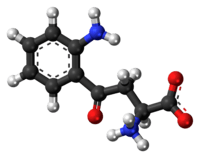Kynurenine
 | |
 | |
| Names | |
|---|---|
| IUPAC name
(S)-2-Amino-4-(2-aminophenyl)- 4-oxo-butanoic acid | |
| Other names
(S)-Kynurenine | |
| Identifiers | |
| 343-65-7 (D/L) 2922-83-0 (L) 13441-51-5 (D) | |
| 3D model (Jmol) | Interactive image |
| ChEBI | CHEBI:57959 |
| ChEMBL | ChEMBL498416 |
| ChemSpider | 141580 |
| DrugBank | DB02070 |
| ECHA InfoCard | 100.005.860 |
| MeSH | Kynurenine |
| PubChem | 846 |
| |
| |
| Properties | |
| C10H12N2O3 | |
| Molar mass | 208.22 g·mol−1 |
| Except where otherwise noted, data are given for materials in their standard state (at 25 °C [77 °F], 100 kPa). | |
| | |
| Infobox references | |
L-Kynurenine is a metabolite of the amino acid L-tryptophan used in the production of niacin.
Kynurenine is synthesized by the enzyme tryptophan dioxygenase, which is made primarily but not exclusively in the liver, and indoleamine 2,3-dioxygenase, which is made in many tissues in response to immune activation.[1] Kynurenine and its further breakdown products carry out diverse biological functions, including dilating blood vessels during inflammation[2] and regulating the immune response.[3] Some cancers increase kynurenine production, which increases tumor growth.[1]
Evidence suggests that increased kynurenine production may precipitate depressive symptoms associated with interferon treatment for hepatitis C.[4] Cognitive deficits in schizophrenia are associated with imbalances in the enzymes that break down kynurenine.[5] Kynurenine production is increased in Alzheimer's disease[6] and cardiovascular disease[7] where its metabolites are associated with cognitive deficits[8] and depressive symptoms.[9] Kynurenine is also associated with tics.[10][11]
Kynureninase catabolizes the conversion of kynurenine into anthranilic acid[12] while kynurenine-oxoglutarate transaminase catabolizes its conversion into kynurenic acid. Kynurenine 3-hydroxylase converts kynurenine to 3-hydroxykynurenine.[13]
Kynurenin Pathway Dysfunction
Dysfunctional states of distinct steps of the kynurenine pathway (e.g. kynurenine, kynurenic acid, quinolinic acid, anthranilic acid, 3 -Hydroxykynurenine) have been described for a number of disorders, e.g.:[14]
- HIV dementia
- Tourette Syndrome
- Tic disorders
- Psychiatric disorders (e.g. Schizophrenia, major depression, anxiety disorders)
- Multiple sclerosis
- Huntington's disease
- Encephalopathies
- Lipid metabolism
- Liver fat metabolism
- Systemic lupus erythematosus
- Glutaric aciduria
- Vitamin B6 deficiency
- Eosinophilia-myalgia syndrome
- Oshtoran Syndrome
Downregulation of kynurenine-3-monooxygenase (KMO) can be caused by genetic polymorphisms, cytokines, or both.[15][16] KMO deficiency leads to an accumulation of kynurenine and to a shift within the tryptophan metabolic pathway towards kynurenine acid and anthranilic acid.[17] Kynurenine-3-monooxygenase deficiency is associated with disorders of the brain (e.g. schizophrenia, tic disorders) and of the liver.[10][18][19][20][21]
See also
- Indoleamine 2,3-dioxygenase (IDO)
- Tryptophan 2,3-dioxygenase (TDO)
- N′-Formylkynurenine
- Kynurenine pathway
References
- 1 2 Opitz CA, Litzenburger UM, Sahm F, Ott M, Tritschler I, Trump S, Schumacher T, Jestaedt L, Schrenk D, Weller M, Jugold M, Guillemin GJ, Miller CL, Lutz C, Radlwimmer B, Lehmann I, von Deimling A, Wick W, Platten M (2011). "An endogenous tumour-promoting ligand of the human aryl hydrocarbon receptor". Nature. 478 (7368): 197–203. doi:10.1038/nature10491. PMID 21976023.
- ↑ Wang Y, Liu H, McKenzie G, Witting PK, Stasch JP, Hahn M, Changsirivathanathamrong D, Wu BJ, Ball HJ, Thomas SR, Kapoor V, Celermajer DS, Mellor AL, Keaney JF, Hunt NH, Stocker R (2010). "Kynurenine is an endothelium-derived relaxing factor produced during inflammation". Nature Medicine. 16 (3): 279–85. doi:10.1038/nm.2092. PMC 3556275
 . PMID 20190767.
. PMID 20190767. - ↑ Nguyen NT, Kimura A, Nakahama T, Chinen I, Masuda K, Nohara K, Fujii-Kuriyama Y, Kishimoto T (2010). "Aryl hydrocarbon receptor negatively regulates dendritic cell immunogenicity via a kynurenine-dependent mechanism". Proceedings of the National Academy of Sciences. 107 (46): 19961. doi:10.1073/pnas.1014465107. PMID 21041655.
- ↑ Capuron L, Neurauter G, Musselman DL, Lawson DH, Nemeroff CB, Fuchs D, Miller AH (2003). "Interferon-alpha–induced changes in tryptophan metabolism". Biological Psychiatry. 54 (9): 906–14. doi:10.1016/S0006-3223(03)00173-2. PMID 14573318.
- ↑ Wonodi I, Stine OC, Sathyasaikumar KV, Roberts RC, Mitchell BD, Hong LE, Kajii Y, Thaker GK, Schwarcz R (2011). "Downregulated Kynurenine 3-Monooxygenase Gene Expression and Enzyme Activity in Schizophrenia and Genetic Association with Schizophrenia Endophenotypes". Archives of General Psychiatry. 68 (7): 665–74. doi:10.1001/archgenpsychiatry.2011.71. PMC 3855543
 . PMID 21727251.
. PMID 21727251. - ↑ Guillemin GJ, Brew BJ, Noonan CE, Takikawa O, Cullen KM (2005). "Indoleamine 2,3 dioxygenase and quinolinic acid Immunoreactivity in Alzheimer's disease hippocampus". Neuropathology and Applied Neurobiology. 31 (4): 395–404. doi:10.1111/j.1365-2990.2005.00655.x. PMID 16008823.
- ↑ Wirleitner B, Rudzite V, Neurauter G, Murr C, Kalnins U, Erglis A, Trusinskis K, Fuchs D (2003). "Immune activation and degradation of tryptophan in coronary heart disease". European Journal of Clinical Investigation. 33 (7): 550–4. doi:10.1046/j.1365-2362.2003.01186.x. PMID 12814390.
- ↑ Gulaj E, Pawlak K, Bien B, Pawlak D (2010). "Kynurenine and its metabolites in Alzheimer's disease patients". Advances in Medical Sciences. 55 (2): 204–11. doi:10.2478/v10039-010-0023-6. PMID 20639188.
- ↑ Swardfager W, Herrmann N, Dowlati Y, Oh PI, Kiss A, Walker SE, Lanctôt KL (2009). "Indoleamine 2,3-dioxygenase activation and depressive symptoms in patients with coronary artery disease". Psychoneuroendocrinology. 34 (10): 1560–6. doi:10.1016/j.psyneuen.2009.05.019. PMID 19540675.
- 1 2 Hoekstra PJ, Anderson GM, Troost PW, Kallenberg CG, Minderaa RB (2007). "Plasma kynurenine and related measures in tic disorder patients". European Child & Adolescent Psychiatry. 16: 71–7. doi:10.1007/s00787-007-1009-1. PMID 17665285.
- ↑ McCreary AC, Handley SL (1995). "Kynurenine potentiates the DOI head shake in mice". Journal of Psychopharmacology. 9 (1): 69–70. doi:10.1177/026988119500900112. PMID 22298697.
- ↑ Kynureninase, European Bioinformatics Institute
- ↑ Saito Y, Hayaishi O, Rothberg S (1957-12-01). "Studies on Oxygenases". The Journal of Biological Chemistry. 229 (2): 921–34. PMID 13502353.
- ↑ Trevor W. Stone: Kynurenines in the CNS: from endogenous obscurity to therapeutic importance. Progress in Neurobiology 64 (2001) 185–218
- ↑ "Neurobiochemie" (in German).
- ↑ Müller N, Myint AM, Schwarz MJ (2011). "Inflammatory biomarkers and depression". Neurotox Res. 19 (2): 308–18. doi:10.1007/s12640-010-9210-2. PMID 20658274.
- ↑ Wonodi I, Stine OC, Sathyasaikumar KV, Roberts RC, Mitchell BD, Hong LE, Kajii Y, Thaker GK, Schwarcz R (2011). "Downregulated kynurenine 3-monooxygenase gene expression and enzyme activity in schizophrenia and genetic association with schizophrenia endophenotypes". Arch. Gen. Psychiatry. 68 (7): 665–74. doi:10.1001/archgenpsychiatry.2011.71. PMC 3855543
 . PMID 21727251.
. PMID 21727251. - ↑ Holtze M, Saetre P, Engberg G, Schwieler L, Werge T, Andreassen OA, Hall H, Terenius L, Agartz I, Jönsson EG, Schalling M, Erhardt S (2012). "Kynurenine 3-monooxygenase polymorphisms: relevance for kynurenic acid synthesis in patients with schizophrenia and healthy controls". J Psychiatry Neurosci. 37 (1): 53–7. doi:10.1503/jpn.100175. PMC 3244499
 . PMID 21693093.
. PMID 21693093. - ↑ Campbell BM, Charych E, Lee AW, Möller T (2014). "Kynurenines in CNS disease: regulation by inflammatory cytokines". Front Neurosci. 8: 12. doi:10.3389/fnins.2014.00012. PMC 3915289
 . PMID 24567701.
. PMID 24567701. - ↑ Buness A, Roth A, Herrmann A, Schmitz O, Kamp H, Busch K, Suter L (2014). "Identification of metabolites, clinical chemistry markers and transcripts associated with hepatotoxicity". PLoS ONE. 9 (5): e97249. doi:10.1371/journal.pone.0097249. PMC 4023975
 . PMID 24836604.
. PMID 24836604. - ↑ Hirata Y, Kawachi T, Sugimura T (1967). "Fatty liver induced by injection of L-tryptophan". Biochim. Biophys. Acta. 144 (2): 233–41. doi:10.1016/0005-2760(67)90153-1. PMID 4168935.